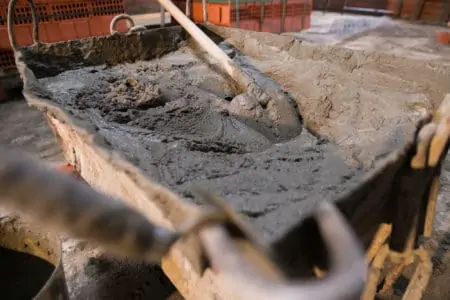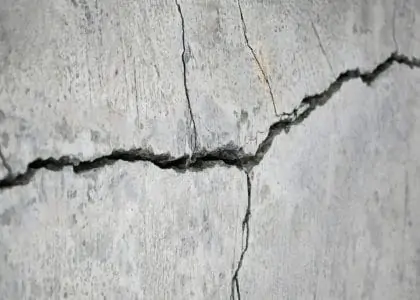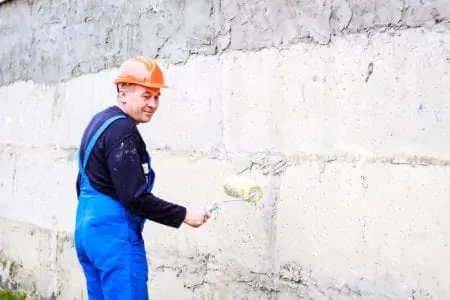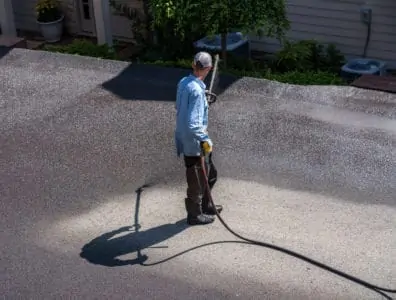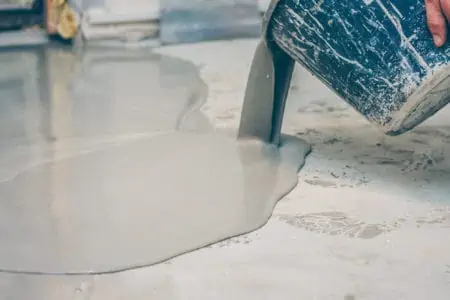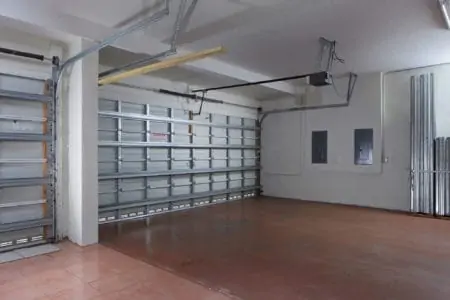Concrete is an important building material. It is one of the building blocks for our cities, our buildings, and infrastructure. So getting the right concrete mix ratio is crucial.
The concrete mixture consists of 4 ingredients: sand, cement, water, and aggregate, and understanding the correct quantities is the difference between getting the right concrete recipe and failure.
Key Takeaways
- Concrete mix ratios are crucial for the right consistency, and the basic ingredients include aggregate, sand, cement powder, and water.
- Common ratios are 1-2-3 and 1-2-4, with higher sand content resulting in weaker concrete and more aggregate leading to increased strength.
- Concrete grades, such as M5, M10, and M15, indicate the minimum strength the concrete should hold after 28 days of curing.
- For a strong concrete mix, use the least amount of water possible, add more rocks or aggregate, and avoid working in high heat.
What Is a Concrete Mix Ratio?
Understanding the concrete mix ratio is vital if you want the correct consistency. Too dry and it will not bond and dry brittle, whereas too wet and it won’t set. You should also consider the type of job you are undertaking and the environment where you place the concrete.
For example, a concrete patio will not get the same punishment as a concrete driveway, so you can change the ratios to suit the task. Your driveway would need more aggregate to make it more robust.
And you really don’t want to be taking any chances when it comes to structures because their strength and building integrity depend on that concrete mix being right.
Basic Ingredients
To understand concrete mix ratios, we first need to know the ingredients and what they do.
Cement
Cement contains calcium oxide, which is produced when you superheat limestone. In essence, cement is a bonding agent, like an adhesive to bind the mixture together. It also contains aluminum, silicon, iron, and a variety of secondary ingredients.
As an ingredient, cement is quite weak on its own. It bonds and dries hard, but it is quite brittle, which is where the aggregate comes in.
Aggregate
Aggregate provides structural strength to the mix. Concrete has compressive strength, which means it can withstand huge amounts of weight, but without the aggregate, it would struggle.
Sand
Sand also has immense compressive strength. When added to the concrete mix, it fills all those small pockets and minimizes air bubbles that could later expose the concrete and weaken the structural integrity.
Water
Water is the ingredient that kick starts the chemical reaction with the quicklime to get it to bond with the aggregate and sand. It also makes the concrete workable, enabling you to mold it to any shape and size.
What Is the 1-2-3 Concrete Mix Ratio?
The 1-2-3 ratio is exactly what the name suggests; 1 part cement powder, 2 parts sand, and 3 parts washed aggregate. Water can be added in any volume depending on how you use the concrete.
If you are putting up fence posts, you want the mixture a little on the wet side so you can pour it into the hole. You also vary the water content to suit your environment because so many factors can affect the mixture.
Are you working in direct sunlight? What’s the moisture content in the atmosphere, and what is the air temperature?
What Is a Concrete Grade?
The concrete grade is the minimum strength the concrete should hold after 28 days of curing. To understand the acronyms used in the formula, we have broken each element down.
M
M stands for the mix of the concrete. So is it a 1-2-3 ratio or a 1-2-4 or a 1-5-10? Each mix varies in compressive strength because the ingredients are adjusted to be compatible with the project.
MPA
MPA stands for megapascal, which is the compressive strength of the concrete. Understanding how much pressure the concrete can withstand is crucial because if the MPA is deficient, it could lead to structural problems down the line.
Without measuring the MPA, cracking and crumbling would occur, and that leads to weaker structural integrity.
PSI
PSI stands for pounds per square inch, and all concrete comes in different strengths, applications, compositions, and types. Understanding the concrete’s compression in pounds per square inch enables us to know when and where to use the concrete.
Most concrete has a PSI of between 2,500 and 5,000.
Types of Concrete Grades
So, now we understand what a concrete grade is, let’s look at the different types.
Nominal
The nominal concrete grade is the most widely used, although it is not the strongest. When you go to the DIY store and pick up ready mixed concrete, this is the grade you would usually get. Nominal is another way of saying a prescribed mix, and it requires no skill to make.
It is great for general repairs and applications that don’t require too much compression. M5, M7.5, M10, M15, M20, and M25 are all nominal mixes of concrete.
Standard
Standard concrete grades are intended for medium to heavier applications. Again, standard grades are sufficient if you are performing general repairs or undertaking some small to medium projects.
The range of concrete mixes classed as standards are M25, which is a 1-1-2 and M30, M35, M40, and M45.
High Strength
As the name suggests, this is the most robust mix of concrete. It is intended for heavy-duty work, like construction and industrial applications.
Typical mix ranges are M50, M55, M60, M65, and M70, which have the strongest PSI rating of 10,150.
Mix Ratio Tables
Nominal Grade
| Concrete Grade | Mix Ratio | MPa | PSI |
| M5 | 1-5-10 | 5 | 725 |
| M7.5 | 1-4-8 | 7.5 | 1087 |
| M10 | 1-3-6 | 10 | 1450 |
| M15 | 1-2-4 | 15 | 2175 |
| M20 | 1-1-5-3 | 20 | 2900 |
Standard Grade
| Concrete Grade | Mix Ratio | MPa | PSI |
| M25 | 1-1-2 | 25 | 3625 |
| M30 | Design mix | 30 | 4350 |
| M35 | Design mix | 35 | 5075 |
| M40 | Design mix | 40 | 5800 |
| M45 | Design mix | 45 | 6525 |
High Strength Grade
| Concrete Grade | Mix Ratio | MPa | PSI |
| M50 | Design mix | 50 | 7250 |
| M55 | Design mix | 33 | 7975 |
| M60 | Design mix | 60 | 8700 |
| M65 | Design mix | 65 | 9425 |
| M70 | Design mix | 70 | 10150 |
What Is the Best Concrete Mix Ratio for the Job?
How the concrete pours and cures is all down to the mix, and the ratios vary according to the task at hand. High-strength concrete ratios include less sand and more aggregate to withstand industrial applications.
The general rule of thumb is the higher the sand content, the weaker the concrete mix. Adding more aggregate gives the mix more tensile strength, which increases the compressive power of the concrete.
Getting the right mix is crucial if you want to get the most from your concrete, and it needs to last the distance.
Below is a chart showing the ratios and the best applications.
| Concrete grade | Environment | Applications |
| C10 | Domestic and commercial | Patios and pathways |
| C15 | Domestic and commercial | Floors, curbs, small commercial projects |
| C20 | Domestic | Floors, garages, workshops |
| C25 | Domestic and commercial | Flooring, building foundations |
| C30 | Commercial | Roads, driveways, heavy-duty flooring |
| C35 | Commercial (large projects) | Walls and pilings |
| C40 | Commercial (large projects) | Heavy traffic roads, farm buildings, and industrial buildings |
Concrete Mixing Tips
What are the best tricks and hints to help you achieve your goals when mixing concrete? Let’s take a leaf out of the professional’s manual and reveal all.
Water Proportions
The single most unpredictable element to mixing concrete is the water. The amount of water you need depends on many factors, including the weather, sunlight, moisture in the air, and temperature.
The more water you add to the mix weakens the cement’s tensile and core adhesive strength. For the most robust concrete, try and use the least amount of water possible. This is challenging when fixing concrete posts for fencing, where the workability of the concrete trumps the extra tensile strength needed.
Add More Rocks
The more rocks you include in the formula, the greater the tensile strength of the concrete. Think of the stones as thousands of tiny hooks holding the concrete mix together.
Mix in Small Batches
If you are working at home and mix too much concrete, you risk it starting to cure before you are ready to use it. It works out to be an expensive mistake and a waste of energy. Working in smaller amounts keeps you in control, and you get lower wastage.
It also puts less strain on your back, arms and wrists.
Don’t Work in High Heat
Heat is your enemy when mixing concrete. It starts to dry the mixture immediately, causing it to start setting. You will then need more water to make the formula wet again, which could reduce the tensile strength of the cement.
Get the Right Tools for the Job
Nothing is as frustrating as trying to get a job done with the wrong tools. If you are mixing concrete,you will need:
- Concrete mixer if you are taking on a significant project.
- A face mask to protect against the quicklime entering your lungs.
- Gloves to keep your hands from touching the corrosive concrete mix.
- A wheelbarrow for smaller jobs.
- Work boots in case you get splashed with the wet mixture.
- Safety glasses to protect your eyes from splashes.
- A shovel to help you mix the concrete by hand.
- A screed to help you level the concrete if you are laying a floor.
- A bucket to help you add the water and move smaller amounts of concrete to the worksite.
- Water to add to the mix to get the right consistency.
- A trowel or spreader to get the concrete into all the edges and corners.
Concrete Mix Calculation
Concrete is measured in cubic yards, so 1 cubic yard equals 27 cubic feet. The easiest way to calculate how much concrete you need is to divide your project area into smaller sections and then multiply them by the thickness of concrete required. Now convert it to cubic yards, and you will know how much concrete you will need.
So, for a standard square or rectangle, you would divide the length by the width by the depth, calculate the total feet and convert it into cubic yards.
It’s All in the Mix
Concrete is useful in so many ways. From minor repairs and maintenance to major infrastructure, buildings, and bridges, concrete is possibly the most important building material on earth. Imagine a world without concrete, and it would look very different.
The great thing about working with concrete is it is very satisfying. It is also forgiving, so you can always add more sand or aggregate to the mix if it’s too wet or more water if too dry. And when you master the mixing ratios, you will be able to make up a batch with your eyes closed.
